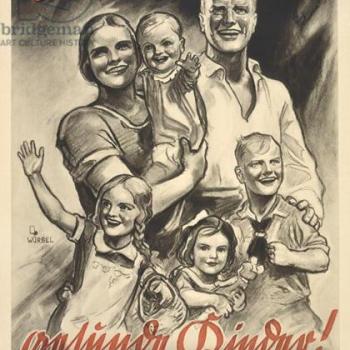Over the holidays I read a novel by Jodi Picoult. I enjoyed the book, but there was one passage that bugged me. In it a mother acts as narrator, and explains that we’re all supposed to say there is no real difference between boys and girls, but that that is a “polite fiction.” She says all you have to do is look into any sandbox at any park, and you’ll see the girls preparing food and the boys smashing things with trucks. Except that this is not in fact my experience.
Look, my son Bobby loves trucks. I’m not denying this. He loves anything that movies. Trains and airplanes seem to be his favorite, though buses, boats, and cars are favorites as well. When we pass a bus he freaks out and starts yelling “BUS!” Sometimes in the parking lot he likes to walk from car to car, stroking them and checking out their wheels. If an airplane passes overhead, he is always the first to hear it and scan the sky, pointing with his chubby finger and hollering “Peh-plane! Peh-plane!” Bobby is rarely out of the house without a matchbox car in each hand.
Some people would call Bobby “all boy.”
But Bobby has other interests as well. He loves animals, from ants to cats to dinosaurs. And he has a way with animals, too. They like him. Bobby also loves his kitchen set, and never tires of cooking me “meals” which I always enjoy quite openly, sipping invisible tea or eating invisible mac-n-cheese. And Bobby has a thing for shoes. The sparklier, the better. Boys’ shoes are boring, it seems.
Until a few months ago, Bobby’s favorite iPad app was candy girl resort. He excelled at giving facials and the other aspects of running a spa. He has since switched his preference to several excellent gender-neutral reading and math apps. One of Bobby’s favorite Netflix features are the recent fairy movies about Tinkerbell and her friends. Alongside Thomas & Friends and Mater’s Tall Tales, Bobby’s other favorites include Barbie: Life in the Dreamhouse and Lego Friends. (Bobby knows how to navigate Netflix on the iPad, so these are his choices, not something we put on for him.)
I don’t look at Bobby and see “all boy.” I look at Bobby and see a curious vibrant child with a variety of interests and a world that is ever expanding. I don’t have a problem with him liking traditionally “boy” things, but I also don’t render his less conventional interests invisible. If Bobby were in a sandbox, he’d be just as likely to be preparing food as he would be to be smashing things with a truck.
And that brings us to Sally. When Sally was Bobby’s age, she loved to build things out of blocks and then smash them. I suspect all children that age love watching blocks fall after knocking down a building or tower. Smashing things is not the domain of boys alone, as any trip to Sally’s daycare playground would tell you. Those girls—they are tough!
Of course, Sally is today very enamored by princesses. Most girls her age are (and these days, boys aren’t immune). Sally has several princess dresses, and loves the Disney princess movies. When we go swimming, she asks to be called Ariel. Sally also enjoys applying makeup (when I let her) and having her fingernails painted. She’s always on the lookout for a dress that spreads out as she spins. She loves dancing and sparkly shoes (and is quickly joined by Bobby when combining these). It would be easy to look at Sally’s interests and type her as a girly girl. But to do that would be to ignore the other half of Sally’s interests.
Sally is a science kid. One of her favorite shows on the iPad is Bill Nye the Science Guy. She can sing the opening sequence through perfectly. But honestly, she simply drinks in the things she learns about the world around her. She doesn’t just watch Bill Nye. She remembers what she sees. Sometimes, too, we turn on dinosaur documentaries, or—her favorite—documentaries about black holes (remember Sally’s theory about Jesus being born out of a black hole?). On a recent doctor’s visit, Sally described black holes with such intense feeling (and accuracy) that she made a lasting impression. She even used hand motions. “I’m pretty sure that when I was five I was primarily worried about where my next popsicle was coming from,” the doctor said, shaking his head in admiration.
Sally is like a creative explosion, but her range isn’t limited to purple or pink. Sally has yet to see walls on her world, so she doesn’t fence herself in. Bugs, dirt, plants, outer space—the kid is unstoppable. She wants to learn to scuba dive so she can learn about the ocean and look for ship wrecks or underwater crime scenes. She wants to ride in an airplane—a step closer to her interest in outer space—and can explain in accurate detail how hot air balloons work. She can explain evolution, and is quick to tell people that we still have dinosaurs among us—birds. And yet she’s never stuck up about any of this. She just wants to share, and is certain everyone around her must be as interested in the things she’s learning as she is.
Sally also has a bit of a penchant for the scary. I think I’ve checked out every book of scary folk stories our library has—or at least, all of the ones with pictures. She’s five, she’s still insisting on pictures. Sometimes we take turns making up ghost stories of our own, and she’s pretty good. Sometimes she has me scared.
Sally’s interest in princesses and dresses and makeup might seem to make her a girly-girl, but few girls are actually that one-dimensional. It seems as though an interest in princesses is enough to assure people that all is well with a girl, while an interest in trucks or trains is enough to assure people that all is well with a boy. And I’m sure there are some girls whose interests are confined to stereotypically “girl” things and some boys whose interests are confined to stereotypically “boy” things. But I’m going to go out on a limb and guess that most children’s interests don’t fit that neatly into one box. It’s just that that complexity gets ignored because most people simply need to see princesses, or trucks, and then they have all the information about they child they need—or so they think.
I realize that the whole nature v. nurture debate is very complicated. I realize that we don’t know everything. But what I think I can say with confidence, both from watching my own children and from watching those around them, is that children’s interests rarely fit simply in the gendered boxes we adults tend to create for them—and I think it does children a disservice to suggest that they do.














